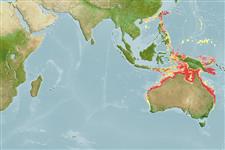Common names from other countries
Environment: milieu / climate zone / depth range / distribution range
Ecologia
; intervalo de profundidade 12 - 52 m (Ref. 8). Tropical; 26°N - 38°S, 112°E - 154°E
Indo-West Pacific: Taiwan and Australia.
Length at first maturity / Tamanho / Peso / Idade
Maturity: Lm ? range ? - ? cm Max length : 10.4 cm TL macho/indeterminado; (Ref. 8)
Total length ranges from 3.8 to 10.4 cm (Ref. 8). Subtidal (Ref. 106854). Occurs at depths from 12.5 to 52 m. Marine environment. Tropical climate (Ref. 8). Pelagic, i.e. recorded in the water column (Ref. 106854).
Life cycle and mating behavior
Maturidade | Reprodução | Desova | Ovos | Fecundidade | Larvas
Members of the order Decapoda are mostly gonochoric. Mating behavior: Precopulatory courtship ritual is common (through olfactory and tactile cues); usually indirect sperm transfer.
Holthuis, L.B. 1980. (Ref. 8)
Status na Lista Vermelha da IUCN (Ref. 130435)
Status no CITES (Ref. 108899)
Not Evaluated
Not Evaluated
Uso pelos humanos
Pescarias: de interesse potencial
| FishSource |
Ferramentas
Mais informação
Idade/Tamanho
Crescimento
Comprimento-peso
Comprimento-comprimento
Morfologia
Larvas
Abundância
Fontes da internet
Estimates based on models
Preferred temperature
(Ref.
115969): 24.5 - 28.8, mean 27.5 (based on 218 cells).
Vulnerabilidade
Low vulnerability (10 of 100).
